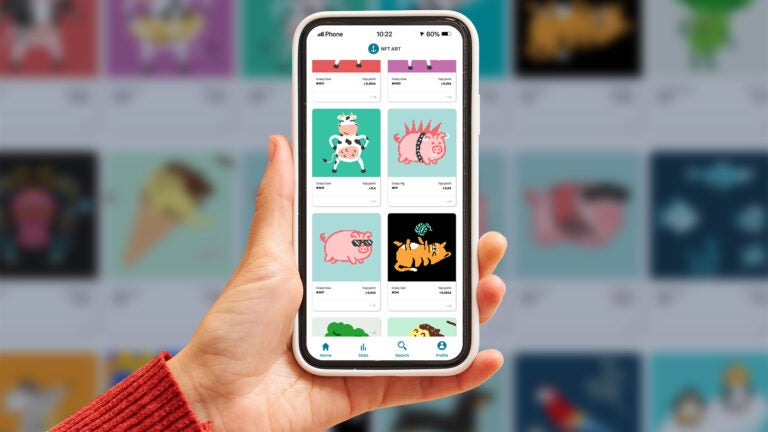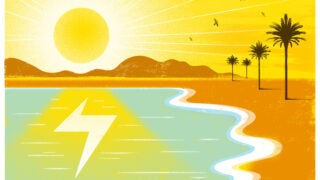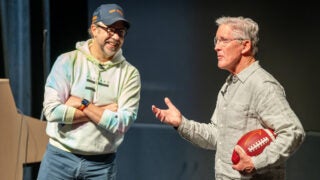
Trojans’ business venture aims to make NFTs more accessible and sustainable
Many people don’t even know what an NFT is (it’s a “non-fungible token”) or how to buy one. This Trojan startup aims to take care of that.
Blake Asherian realizes that most people don’t have a spare $60,000 just lying around — which is about what you’d need to buy an NFT (non-fungible token) of any real value. He also understands that at a broader level, most people don’t even know what an NFT is or how to buy one.
That’s why Asherian and three other Trojans — Gabriel Perez, Matthew Hausman and Can Toraman — have started Moonlight, a fractionalized NFT marketplace that allows users to buy, own and sell fractions of an NFT in a simple and user-friendly way.

Despite gaining significant traction within the last year, NFTs are still in their infancy, and there are financial risks involved given their uncertainty and high price tags. Moonlight hopes to remedy that, or at least help bridge the gap between most people and this emerging space.
“If the average personal income is 63K, and the average cost of a blue-chip NFT is 51K, that’s a big problem,” said Asherian, a business administration undergraduate in the USC Marshall School of Business.
“Part of the reason why people are not as prone to getting into NFTs is because there’s such a high barrier in terms of knowledge, and technology,” Asherian added. “We’re breaking down that barrier.”
How to buy NFTs: ‘Non-fungible tokens’ explained
The concept of Moonlight is simple: A group of people will choose an NFT they want to crowdfund, and once the funding goal is reached, each crowdfunder becomes a co-owner. From there, co-owners can buy and sell their fractions on Moonlight’s platform.
Though the platform might be simple — or at the least the goal is to make it as simple as possible for people — the concept of an NFT isn’t widely understood and can seem a little daunting.
Essentially, an NFT is a unique piece of digital art that is certified using blockchain, an immutable record of ownership. The non-fungible part means that no two items are alike or equal. NFTs function similarly to how people collect and sell art or trading cards. Some items are worth next to nothing, while others fetch millions of dollars.
Moonlight’s goal is for people to have the opportunity to own fractions of NFTs of real value, which is why the company focuses on “blue chip” — or most valuable — NFTs, like Bored Ape or CryptoPunks, which have the potential to provide long-term returns and can easily go for six figures.
But why would a digital image of an ape or a pixelated person be worth hundreds of thousands of dollars?
Well, why would someone pay over $7 million for a baseball card? Or thousands for any of the “contemporary art” listed on Sotheby’s?
All are fair questions, and the answers could vary depending on the person or item. The common factor is that collectors feel that these are assets that will increase in value. NFTs are just the newest version.
I would always argue with people: What is the difference between your trading card and an NFT? They took a picture of a guy and then put it on a piece of paper, and it has value somehow.
Matthew Hausman, Moonlight frontend architect
“I would always argue with people: What is the difference between your trading card and an NFT?” said Hausman, Moonlight frontend architect and 2021 USC Viterbi School of Engineering graduate.
“They took a picture of a guy and then put it on a piece of paper, and it has value somehow.”
Crowdfunding, fractionalization and reaching the 99%
For those who only read certain media accounts, it may seem like NFTs and the cryptocurrency used to buy them are a losing venture, and they might be for some. However, the creators of Moonlight were quick to point out that there are a lot of financial risks out there, and their platform’s crowdfunding feature can help eliminate some of those potential dangers.
With Moonlight, crowdfunding is key. Users select an NFT and then have a certain number of days to raise the funds. If the money is raised in time, the NFT is moved to the Moonlight platform where people can buy and sell shares. If the funds are not raised in time, then everyone who contributed gets their money back.
“No other protocol allows you to literally raise funds to buy cool stuff together,” Asherian said. “The secret sauce here is having a technology that can allow any number of people to put their money into something and as a group get anything they want.”
The next concept, fractionalization, is not necessarily new, but how Moonlight allows users to fractionalize is in direct response to a large issue within the NFT community. Right now, someone who owns an NFT can fractionalize it and sell those fractions at whatever price they see fit, regardless of the actual market value. People who are knowledgeable about and can afford a six-figure blue-chip NFT don’t have a need for fractionalization. So, the practice can take advantage of those who are new to the space — a problem that Moonlight wants to correct.
“For a bunch of people who are just entering the space of NFTs, how can they trust that that valuation is true?” Asherian said. “They don’t know enough about the protocols or the NFT collections. They’re kind of swayed in an untrue direction and it’s unfair to them.”
Asherian and his team at Moonlight emphasize that their platform is truly for everyone. NFTs — and even the cryptocurrency used to purchase them — might seem daunting for those who aren’t already in that world, but their hope is to take away some of that hesitance.
“At the end of the day, if you look at who’s into NFTs, it’s that 1%, right?” Asherian said. “We want to tap into the 99%, so we have to create a product that’s comprehensive for that group, which not too long ago included myself.”
From crypto to NFTs
The initial concept for Moonlight came to Asherian in late 2021, but his interest in NFTs started around two years ago when he was working for his cousin, Sean Rad, the founder and former CEO of the dating app Tinder. Rad — at one time at USC student — had invested in Genies, an avatar technology company, and Genies co-founder Akash Nigam started talking to Asherian about the company’s venture into NFTs. Though Asherian knew nothing about NFTs or blockchain, the concepts piqued his interest.
Soon after, he left his jobs to buy and sell NFTs full time. He admits that there were some definite growing pains early on because of the high barrier to entry, but those missteps put him in a position to succeed down the road.
He started drafting up the concept for Moonlight while studying abroad in Paris last year. He connected with fellow Trojans abroad which led to even more connections when he returned stateside. Asherian credits USC with introducing him to Perez, Hausman and Toraman, and making Moonlight what it is today.
Ever since I was a freshman, I’ve always heard that term ‘Trojan Family,’ but then I was really able to witness what it can do.
Blake Asherian, Moonlight CEO and founder
“I really believe in the Trojan Family and what it offers,” Asherian said. “Ever since I was a freshman, I’ve always heard that term ‘Trojan Family,’ but then I was really able to witness what it can do.”
A transfer student from the University of Wisconsin-Madison, Perez said his interest in NFTs has been a gradual progression since he was in high school. He started by selling stocks with his friends, and then in college he found a new interest in cryptocurrency.
“I kind of fell in love with the philosophy behind Bitcoin, which is a very anti-centralization of money, anti-central banks, power-back-to-the-people sort of thing,” said Perez, a junior economics major in the USC Dornsife College of Letters, Arts and Sciences.
“Then I learned about Ethereum, which was the first time I realized this has a huge potential to be the currency of the internet in the future.”
Ultimately, Perez, product and community lead at Moonlight, felt that if he wanted to further his career in the crypto world, he’d have to move somewhere where he felt it was more popular and valued. He found just such an innovative environment at USC, where USC Viterbi even offers a blockchain minor.
He came to USC before the fall 2021 semester and joined Blockchain@USC — a student-run organization that engages with blockchain-related topics, develops blockchain applications, and connects with industry professionals — as the director of external relations.
We started talking about fractionalizing NFTs and the ability for smaller capital players to be able to dive into these collections, and I was hooked from there.
Gabriel Perez, Moonlight, product and community
At USC, both within his field of study and social groups, Perez surrounded himself with other like-minded people that shared his passion, which is when he first heard about NFTs and eventually met Asherian.
“We started talking about fractionalizing NFTs and the ability for smaller capital players to be able to dive into these collections, and I was hooked from there,” Perez said.
By the end of the spring 2022 semester, Perez and Asherian had formed the Moonlight team formed and started the work to launch their idea.
How to buy NFTs: trust, sustainability and the path ahead
The Moonlight crew is aware of some of the sustainability concerns with NFTs, primarily the proof-of-work blockchain system that is used by most cryptocurrencies so that transactions can be processed peer-to-peer in a secure manner without the need for a third party. Proof-of-work consumes a significant amount of energy. Rooms full of computers are needed to run complex mathematical equations, and coolers are needed to make sure those computers don’t overheat. By one estimate, mining 1 Bitcoin consumes as much electricity as a standard American home would use in nine years.
Most NFTs are part of the Ethereum blockchain, which currently uses proof-of-work. However, next month the Ethereum “Merge” will shift its blockchain to proof-of-stake, which uses 99.95% less energy by reducing the amount of computational work needed to verify the blocks and transactions that keep the blockchain secure.
“Fingers crossed that ‘Merge’ goes well because it’s a very anticipated catalyst in the crypto world,” Perez said. “If it does go correctly, NFTs are probably not going to have much of an environmental footprint at all, compared to something like a few office buildings downtown.”
But before they get to the point of using more sustainable blockchain, Asherian said they must establish their footing. Moonlight is projected to go live later this fall, and Asherian said once they’ve developed their community and built trust, they can influence people to move towards more sustainable methods.
“When you’re a huge marketplace that everyone starts suspecting has authority within the NFT space, then you’re able to sort of tell them what to do next,” Asherian said. “We really want to be able to gain that authority, and the way to do so is by being transparent, simple and fun.”
Trust and NFTs — or crypto, for that matter — might not go hand-in-hand just yet for much of the general population, but that’s exactly what Moonlight is hoping to fix. They see NFTs as an opportunity not just for those “in the know,” but for everyone.
“We believe there is power in numbers,” Asherian said. “At the end of the day, we want to give power to the people so they can own anything they want, together.”



